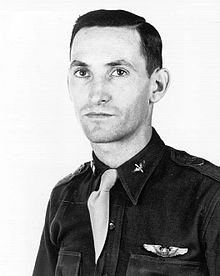George Andrew Davis Jr. | |
|---|---|
 Davis in 1945 | |
| Nickname(s) | |
| Born | December 1, 1920 Dublin, Texas, U.S. |
| Died | February 10, 1952 (aged 31) Yalu River, North Korea |
| Cenotaph | City of Lubbock Cemetery, Lubbock, Texas, U.S. |
| Allegiance | United States |
| Service | |
| Years of service | 1942–1952 |
| Rank | Lieutenant Colonel (posthumous) |
| Service number | |
| Unit | |
| Commands | 334th Fighter-Interceptor Squadron |
| Battles / wars | |
| Awards | |
George Andrew Davis Jr. (December 1, 1920 – February 10, 1952) was a highly decorated fighter pilot and flying ace of the United States Army Air Forces in World War II, and later of the United States Air Force during the Korean War. He was killed in action during a combat mission in northwestern Korea, in an area nicknamed "MiG Alley". For his actions during the Korean War, Davis was posthumously awarded the Medal of Honor and promoted from major to lieutenant colonel.
Born in Dublin, Texas, Davis joined the United States Army Air Corps in early 1942. He was sent to the Pacific Theater after pilot training and flew in the New Guinea and Philippine campaigns, scoring seven victories over Japanese aircraft. He quickly gained a reputation as a skilled pilot and accurate gunner whose "daredevil" flying style contrasted with his reserved personality.
Davis did not see action in Korea until late 1951. Despite this, he achieved considerable success flying the F-86 Sabre fighter jet, quickly rising to become the war's ace of aces and downing fourteen North Korean, Chinese, and Soviet aircraft before his death in February 1952. During his final combat mission in northwestern Korea, Davis surprised and attacked twelve Chinese MiG-15 fighter jets, downing two of the MiG-15s before he was shot down and killed. Davis was the only flying ace of the United States to be killed in action in Korea. Controversies remain surrounding the circumstances of his death.
Davis is the fourth-highest US scoring ace of the Korean War, with a total of 14 victories added to the 7 he scored in World War II. He is one of seven US military pilots to become an ace in two wars, and one of 31 US pilots to be credited with more than 20 victories.[4]
- ^ a b King 1952, p. 8
- ^ "Air Force Award Cards [Silver Star]". U.S. National Archives and Records Administration. March 19, 1952. Retrieved May 25, 2024.
- ^ Korean War Honor Roll listing: George Andrew Davis Jr. entry, American Battle Monuments Commission, retrieved October 1, 2011
- ^ "Medal of Honor, Major George Andrew Davis, Jr., United States Air Force". www.thisdayinaviation.com. February 10, 2023.